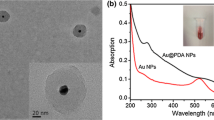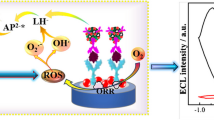Abstract
An electrochemiluminescence-based immunoassay using quantum dots (QDs) as labels for the carcinoembryonic antigen (CEA) was developed using an electrode modified with leafs of nanoporous gold. CEA was initially immobilized on the electrode via a sandwich immunoreaction, and then CdTe quantum dots capped with thioglycolic acid were used to label the second antibody. The intensity of the ECL of the QDs reflects the quantity of CEA immobilized on the electrode. Thus, in the presence of dithiopersulfate as the coreactant, the ECL serves as the signal for the determination of CEA. The intensity of the electroluminescence (ECL) of the electrode was about 5.5-fold higher than that obtained with a bare gold electrode. The relation between ECL intensity and CEA concentration is linear in the range from 0.05 to 200 ng.mL-1, and the detection limit is 0.01 ng.mL-1. The method has the advantages of high sensitivity, good reproducibility and long-term stability, and paves a new avenue for applying quantum dots in ECL-based bioassays.

Electrochemiluminescence Immunoassay Based on CdTe Quantun Dots as labels at Nanoporous Gold Leaf electrode






Similar content being viewed by others
References
Richter MM (2004) Electrochemiluminescence (ECL). Chem Rev 104:3003–3036
Miao WJ (2008) Electrogenerated chemiluminescence and its biorelated applications. Chem Rev 108:2506–2553
Wilson R, Clavering C, Hutchinson A (2003) Electrochemiluminescence enzyme immunoassays for TNT and pentaerythritol tetranitrate. Anal Chem 75:4244–4249
Eskola J, Mäkinen P, Oksa L, Loikas K, Nauma M, Jiang QH, Håkansson M, Suomi J, Kulmala S (2006) Competitive immunoassay by hot electron-induced electrochemiluminescence detection and using a semiautomatic electrochemiluminometer. J Luminescence 118:238–244
Wang SJ, Milam J, Ohlin AC, Rambaran VH, Clark E, Ward W, Seymour L, Casey WH, Holder AA, Miao WJ (2009) Electrochemical and electrogenerated chemiluminescent studies of a trinuclear complex, [((phen)2Ru(dpp))2RhCl2]5+, and its interactions with calf thymus DNA. Anal Chem 81:4068–4075
Zhan W, Bard AJ (2007) Electrogenerated chemiluminescence immunoassay of human C-reactive protein by using Ru(bpy) 2+3 -encapsulated liposomes as labels. Anal Chem 79:459–463
Tian DY, Duan CF, Wang W, Li N, Zhang H, Cui H, Lu YY (2009) Sandwich-type electrochemiluminescence immunosensor based on N-(aminobutyl)-N-ethylisoluminol labeling and gold nanoparticle amplification. Talanta 78:399–404
Bertoncello P, Forster RJ (2009) Nanostructured materials for electrochemiluminescence (ECL)-based detection methods: Recent advances and future perspectives. Biosens Bioelectron 24:3191–3200
Jie GF, Liu P, Wang L, Zhang SS (2010) Electrochemiluminescence immunosensor based on nanocomposite film of CdS quantum dots-carbon nanotubes combined with gold nanoparticles-chitosan. Electrochem Commun 12:22–26
Jie GF, Zhang JJ, Wang DC, Cheng C, Chen HY, Zhu JJ (2008) Electrochemiluminescence immunosensor based on CdSe nanocomposites. Anal Chem 80:4033–4039
Jie GF, Li LL, Chen C, Xuan J, Zhu JJ (2009) Enhanced electrochemiluminescence of CdSe quantum dots composited with CNTs and PDDA for sensitive immunoassay. Biosens Bioelectron 24:3352–3358
Jie GF, Liu B, Pan HC, Zhu JJ, Chen HY (2007) CdS nanocrystal-based electrochemiluminescence biosensor for the detection of low-density lipoprotein by increasing sensitivity with gold nanoparticle amplification. Anal Chem 79:5574–5581
Jie GF, Huang HP, Sun XL, Zhu JJ (2008) Electrochemiluminescence of CdSe quantum dots for immunosensing of human prealbumin. Biosens Bioelectron 23:1896–1899
Ding Y, Erlebacher J (2003) Nanoporous metals with controlled multimodal pore size distribution. J Am Chem Soc 125:7772–7773
Ding Y, Chen MW, Erlebacher J (2004) Metallic mesoporous nanocomposites for electrocatalysis. J Am Chem Soc 126:6876–6877
Ding Y, Kim YJ, Erlebacher J (2004) Nanoporous gold leaf: “ancient technology”/ advanced material. Adv Mater 16:1897–1900
Hammarström S (1999) The carcinoembryonic antigen (CEA) family: structures, suggested functions and expression in normal and malignant tissues. Semin Cancer Biol 9:67–81
Eppler E, Hörig H, Kaufman HL, Groscurth P, Filgueira L (2002) Carcinoembryonic antigen (CEA) presentation and specific T cell-priming by human dendritic cells transfected with CEA-mRNA. Eur J Cancer 38:184–193
Schneider J (2006) Tumor markers in detection of lung cancer. Adv Clin Chem 42:1
Gould DA, Moscoso GJ, Young MPA, Barton DP (2000) Human first trimester fetal ovaries express oncofetal antigens and steroid receptors. J Soc Gynecol Investig 7:131–138
Chu TM, Reynoso G (1972) Evaluation of a new radioimmunoassay method for carcinoembryonic antigen in plasma, with use of zirconyl phosphate gel. Clin Chem 18:918–922
Mekler VM, Bystryak SM (1992) Application of o-phenylenediamine as a fluorogenic substrate in peroxidase mediated enzyme-linked immunosorbent assay. Anal Chim Acta 264:359–363
Yuan JL, Wang GL, Majima K, Matsumoto K (2001) Synthesis of a terbium fluorescent chelate and its application to time-resolved fluoroimmunoassay. Anal Chem 73:1869–1876
Wang F, Hu SS (2009) Electrochemical sensors based on metal and semiconductor nanoparticles. Microchim Acta 165:1–22
Tang DY, Xia BY (2008) Electrochemical immunosensor and biochemical analysis for carcinoembryonic antigen in clinical diagnosis. Microchim Acta 163:41–48
Fu XH, Wang JY, Li N, Wang L, Pu L (2009) Label-free electrochemical immunoassay of carcinoembryonic antigen in human serum using magnetic nanorods as sensing probes. Microchim Acta 165:437–442
Hu XF, Wang RY, Ding Y, Zhang XL, Jin WR (2010) Electrochemiluminescence of CdTe quantum dots as labels at nanoporous gold leaf electrodes for ultrasensitive DNA analysis. Talanta 80:1737–1743
Yu WW, Qu LH, Guo WZ, Peng XG (2003) Experimental determination of the extinction coefficient of CdTe, CdSe, and CdS nanocrystals. Chem Mater 15:2854–2860
Jiang KY, Schadle LS, Siegel RW, Zhang XJ, Zhang HF, Terrones M (2004) Protein immobilization on carbon nanotubes via a two-step process of diimide-activated amidation. J Mate Chem 14:37–39
Acknowledgments
This project was supported by the National Natural Science Foundation of China (Grant No. 20975061), the National Basic Research Program of China (Grant No. 2007CB936602), the Natural Science Foundation of Shandong Province in China (Grant No. Y2008B20). We are grateful to Professor Yi Ding’s group (School of Chemistry and Chemical Engineering, Shandong University) for providing the NPGL.
Author information
Authors and Affiliations
Corresponding author
Rights and permissions
About this article
Cite this article
Li, X., Wang, R. & Zhang, X. Electrochemiluminescence immunoassay at a nanoporous gold leaf electrode and using CdTe quantun dots as labels. Microchim Acta 172, 285–290 (2011). https://doi.org/10.1007/s00604-010-0487-x
Received:
Accepted:
Published:
Issue Date:
DOI: https://doi.org/10.1007/s00604-010-0487-x




